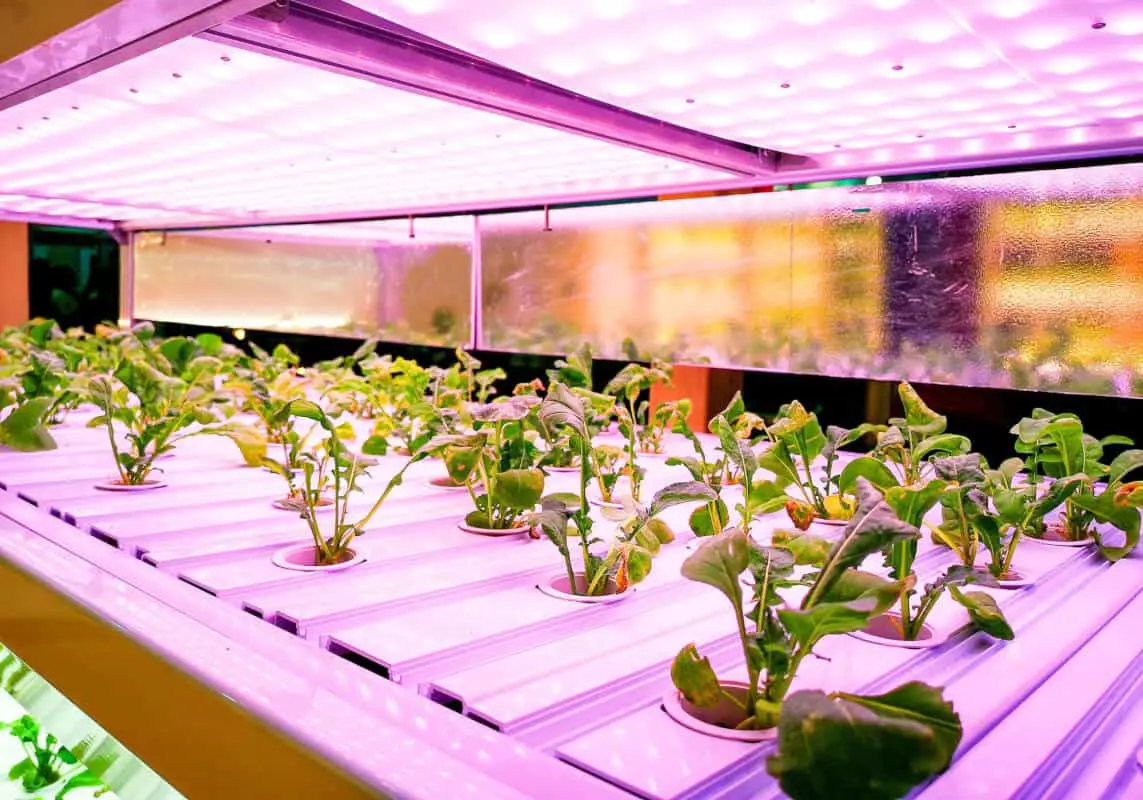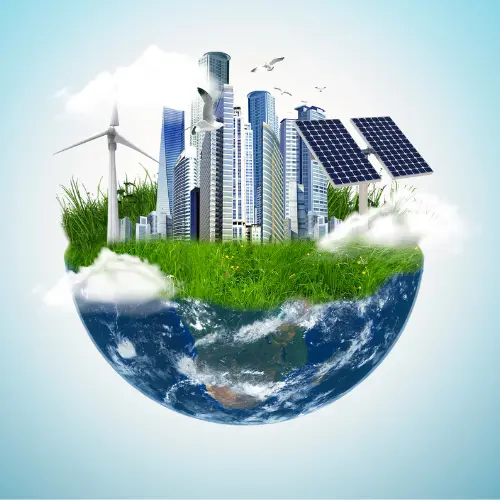If you’ve recently entered into the world of indoor growing, or you know someone who has, you might be fascinated with the purple illumination of lights that are commonly used for growing indoor plants. These lights give off a calming yet exciting hue of purple. Unless of course, you absolutely despise the color purple in which case you probably don’t care.
These lights raise a few questions though, and the main one being, why are grow lights purple? There is actually a lot of scientific research behind colored grow lights and their benefits for plant growth. The shorter the wavelength the color emits, the more energy it provides to the plant. Purple has the shortest, and therefore, it is most commonly used to grow plants.
Purple is not the only color used though to grow plants. Let’s walk through a few of them in this article.
Different Colored Grow Lights and Their Purpose
Although purple is one of the most commonly used colors for grow lights, you will also find grow lights that are blue, red, and green. The light you choose will depend on the needs of the plants that you are growing.
Purple Grow Lights (380-450nm wavelength)
While purple has the shortest wavelength thus providing more energy to the growing plants next to UV-A and UV-B, there’s another reason that a lot of grow lights come out purple, and it’s because plants actually need blue and red lights at the same time for critical growth and development. How does that make sense as it pertains to a purple light though?
Most LED manufacturers choose to incorporate red and blue combination chips into their lights to provide the benefits of both of these colors. When you combine these two colored chips, you get, the familiar and distinct purple or pink hue. This is just something you learned in elementary school when mixing your primary colors.
Blue Grow Lights (400-500nm wavelength)
With a slightly longer wavelength than purple at 400-500nm, blue lights actually help with photosynthesis and vegetative growth. The vegetative growth only affects the foliage and not the plant itself. In fact, plants grown exclusively with blue lights, are typically shorter, they just have thicker leaves and look much more green than those grown without blue lights.
At high-intensity, blue grow lights can sometimes help with flowering encouragement but it is not common to use only blue as a means to promote flowering. Blue LED lights actually emit so much high energy that humans should be wary of looking directly into them without some form of protection for the eyes. While the light appears dim to us, it’s actually not safe for your eyes.
Red Grow Lights (630-660nm wavelength)
Red is the color that is responsible for increasing flowering and fruit development. Red also helps with seed germination and root growth so it is commonly used the most during the early stages of the plant’s life. You’re probably starting to realize now why red and blue are combined into a purple light that’s used for growing plants. Both colors are the most needed for growth.
Alternatively, if you notice your plant is lacking in one area more than the other you can supplement it. Maybe vegetative growth and leaf color are fine, but your plant is not flowering when you know it should be, it might be time to add in more red light and vice versa. You can give your plants a red light by using incandescent bulbs, blue requires fluorescent.
Green Grow Lights (500-565nm wavelength)
A common misconception with using grow lights is that your plants really only need blue and red to grow successfully. Plants can benefit significantly from the effects of green lights as well. Green promotes vegetation, germination, and flowering and it does this by allowing light to reach lower branches of the plant.
Green is the one light that can easily penetrate the plant canopy allowing it to effectively reach these areas. Usually, young plants are not able to produce decent amounts of chlorophyll which is a pigment found in the color green. This pigment helps with trapping light for photosynthesis. Providing green light to these smaller plants helps to provide them with increased chlorophyll.
LED Vs. Fluorescent, Which is Better?
LED lights boast the following benefits over fluorescent:
- They are energy efficient and save the user money
- You don’t have to worry about toxic vapors
- They are adjustable and use spectral tuning which maximizes yields
- LEDs provide the closest light to natural light
LED lights last much longer and require less energy to use. Did you know that fluorescent bulbs can be toxic? I’ll be honest, I didn’t know either until I started researching why LED’s are a better choice. Fluorescent bulbs actually emit mercury vapor. This vapor helps to transport electrical currents through the bulb.
We all know mercury is a toxic heavy metal, whenever you break a fluorescent bulb, you’re releasing this vapor into the air around you and breathing it in. This is why it’s difficult to even recycle these bulbs, and it leads to environmental pollution. Mercury pollution directly affects the brain, lungs, and other critical organs.
Learn more about the dangers of mercury from the World Health Organization here.
LED lights instead use an electrical current that runs through a chip to produce light. This chip has tiny diodes, which then illuminate. This, of course, is completely non-toxic and very safe. Additionally, LED lights do not get as increasingly warm as fluorescent lights do. Have you ever put your hand on a fluorescent light that’s been on for an extended period? It’s going to be warm.
LED lights don’t get warm like this, and this makes it much safer for the plants. Fluorescent bulbs can make too warm of an environment, doing more damage than good. This is not to say though that LED lights don’t produce heat at all, they do, but they are commonly manufactured with a heat sink in the base which takes the heat and dissipates it into the air, thus keeping the bulb cool.
Things To Know Before Buying Grow Lights
There are three types of grow lights that are commonly sold on the market:
- HID high-intensity discharge lights – produced of a glass tube that utilizes gases and metal salts to pass electric currents between tungsten electrodes. These lights are very powerful, but they are pricey.
Checkout HID grow lights on Amazon.
- CFL compact fluorescent – These, of course, are fluorescent bulbs that might be used for growing and which we’ve already discussed the pros vs. cons with LED lights.
Check out CFL grow lights on Amazon.
- LED light-emitting diode – cost-efficient bulbs that produce more energy, last longer, and use a chip to produce light through illuminated diodes.
Check out LED grow lights on Amazon.
Before you purchase and set up your lights, you need to determine the following:
- What is the proper distance you should keep between your lights and plants for optimal growth?
- Depending on the plant you are growing, will you need to change the height of the light at different growth stages?
- Do you also have the proper fans, filters, tents, and ducting or clamps? A lot of quality light kits that you can purchase will include all of these.
- What is the scale of growth you desire? For example, CFL bulbs are best for small grows, while HID is the best for large commercial grows.
Safety of lights:
If children or small dogs have access to the areas where grow lights may be present, you may want to stick LED grow lights. These lights tend to be more durable and less prone to breakage if knocked over. They also don’t produce mercury vapors that can cause brain damage.
Make sure that your lights are plugged into a proper 220V outlet. If you don’t use the proper outlet, you risk overload, especially if used for long periods of time, this is more likely to cause a fire than the heat that is emitted by the bulbs.
Light cycles can increase the promotion of mold or mildew growth, which will eventually affect your health. Make sure to check and clean areas where you might find it present.



Subscribe To Our Newsletter
Join our mailing list to receive news and updates. Don't worry. We will not smap you ;)
You have Successfully Subscribed!